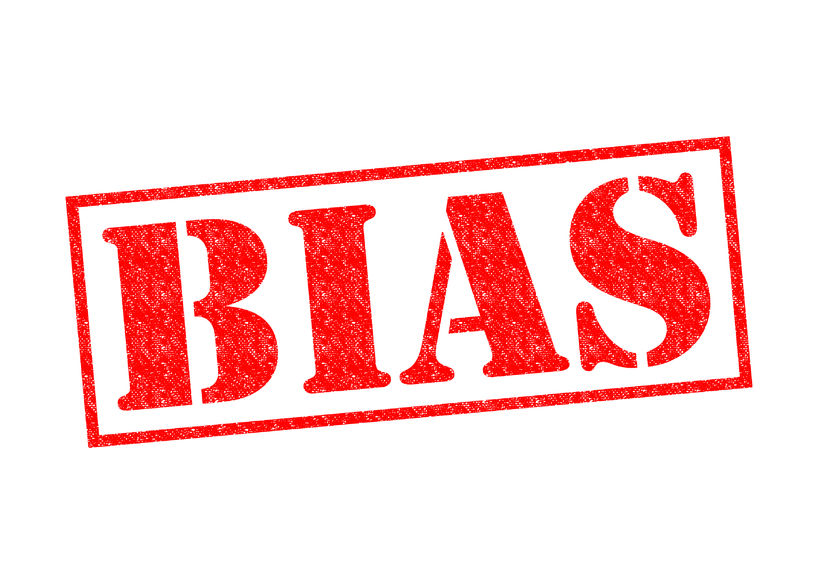I’ve written about bias on a number of occasions – here , for example, and here – and I continue to believe it is one of the most significant barriers to learning that human beings face.
By bias, I mean “a particular tendency or inclination, esp. one that prevents impartial consideration of a question.” [Free Dictionary].
Bias is not automatically negative. In some cases, our biases make it much more possible to navigate a very complex and often confusing world. In other cases, however, it can, almost by definition, make it challenging for us to bring an open, receptive mind to situations that require learning. It can impact our availability to learn.
This challenge is, of course, multiplies when the learning required involves really complex problems that intersect with deeply held beliefs and that require collaboration and compromise among people who hold different beliefs. Global warming, for example. Or how to address healthcare reform or racial tensions in the U.S.
And the challenge becomes still greater when we acknowledge that we are all biased, to varying degrees, in one way or another. As Howard Ross puts it in his excellent book Everyday Bias:
Possessing bias is part and parcel of being human. And the more we think we are immune to it, the greater the likelihood that our own biases will be invisible or unconscious to us.
Ross highlights ten patterns of bias in his book. In this post, I list and summarize those patterns and then add my thoughts on the learning problems they may cause.
Bias Patterns and Related Learning Problems
I’ll note up front that some of these biases are quite similar, but it is worth pulling them apart, as Ross has done, to understand the nuances involved – and to better prepare ourselves to overcome the barriers to learning they may create.
Bias Pattern #1: Selective Attention
Ross describes this as “a mental process through which we selectively see some things but not others, depending upon our point of focus, or what we happen to be focusing on at a particular time.”
Think, for example, of when you decide to get a new type of smartphone. Chances are good that you suddenly become much more aware of others using that same type of smartphone. You will start to see it everywhere, when previously you paid it no attention whatsoever.
Potential Learning Problem: The selective attention bias can apply to just about anything in our lives, not just smartphones or other consumer items. If we are unable or unwilling to take in information that falls outside of our immediate focus, we may fail to learn what we need in order to answer a question or solve a problem correctly. We may form incomplete, even incorrect memories.
Bias Pattern #2: Diagnosis Bias
Ross describes this as “the propensity to label people, ideas, or things based on our initial opinions.” You might think of this the “curse of first impressions.” We are subject to it, very often multiple times on a daily basis.
Potential Learning Problem: We simply don’t go deep enough. We assume we have enough information, and the right information when there is probably no way we really could. Worse, we do this unconsciously, and as a result, unquestioningly. As a result, we acquire false knowledge and perhaps fail to alter harmful behaviors and beliefs.
Bias Pattern #3: Pattern Recognition
Of course, patterns themselves can be an issue. We can all fall prey to “… the tendency to sort and identify information based on prior experience or habit.” This is perhaps the most pernicious form of mindless learning – or, really, non-learning. “X meant Y before, so X must mean Y now.”
Stereotyping falls into this pattern. We stereotype when we generalize from a specific. For example, we see a person of a particular ethnicity, religion, gender, or race act in a particular way and we assume, whether consciously or unconsciously, that other people in that group must act the same way.
Potential Learning Problem: With the pattern recognition bias, we make the assumption that we have correctly understood prior patterns – and that they really were patterns. We do not account for the fact that the initial pattern could have been an anomaly. Nor do we account for change – whether disruptive or incremental – that leads to patterns no longer holding. As a result, we fail to even recognize the need to learn.
Bias Pattern #4: Value Attribution
Or, “misattribution” may actually be a better way to put this. This pattern reflects “… the inclination to imbue a person or thing with certain qualities based on initial perceived value.”
To illustrate this bias, Ross tells the story of how virtuoso violinist Joshua Bell once posed as a street musician outside the entrance to a Metro stop in Washington, DC:
Bell was dressed in a baseball cap and a long-sleeved T-shirt. He opened his violin case and took out his $ 3.5 million violin , threw a few dollars in the case to encourage others, as thousands of other street musicians have done before. He then played for forty-five minutes. Almost nobody stopped to listen. Was it because they didn’t like the music? Not likely. People all over the world pay more than $ 100 a seat to listen to Bell perform. They simply didn’t assign a lot of value to this “street musician.”
While this is a particularly stark illustration of the value attribution bias, we unknowingly have similar experience all the time simply because we apply only a superficial level of attention to most of what goes on around us.
Potential Learning Problem: We may fail to engage in situations where engagement would actually be highly valuable. Alternatively, we may make unnecessary learning investments in the name of achieving value that is, in fact, already present. After all, “Oz never did give nothing to the Tin Man that he didn’t already have.”
Bias Pattern #5: Confirmation Bias
Chance are good that you have heard of this one before. Ross defines it as “…a tendency for people to gather information or respond to a circumstance in a way that confirms their already established beliefs or ideas.” We see a lot of this going on in the U.S. right now: “Of course that’s how _______________ (Democrats/Republicans/Trump followers) are going to act.”
Potential Learning Problem: The confirmation bias prevents us from seeing and understanding different perspectives, insights, and even hard factual data that – regardless of whether our current knowledge is not technically “wrong” – could produce better, more effective, or more elegant outcomes.
Bias Pattern #6: Priming
Ross defines this bias as “…the implicit tendency to respond to something based on expectations created by a previous experience or association.” Many people may decide not to fly after a major plane crash, for example. Or, the trigger may be something much more subtle. We might, for example, be more critical of people interviewing for a job on a day when it is raining outside versus one when it is sunny outside.
Priming can, of course, be very positive. It can, for example, fuel motivation for positive learning experiences. We might watch Wimbledon and then feel especially motivated to go out and practice tennis. Or listen to an interview with a famous author and feel inspired to sit down and write a blog post or a book chapter.
Potential Learning Problem: The main issue with priming is that it can prompt mindless actions and reactions and cause a failure of the basic comprehension that is fundamental to learning. The odds of a plane crashing at any time, for example, are very low, and any increase in crashes following a crash is almost certainly coincidental.
Bias Pattern #7: Commitment Confirmation
This bias involves a tendency to remain “…attached to a particular point of view, even when it may be obviously wrong, especially when it provides us a way to save face, appear right, or allow us to glorify ourselves.” It is illustrated by the sort of intellectual stubbornness (or, in some cases, flat out dishonesty) we see playing out daily in the current U.S. political environment.
Ross doesn’t mention it, but I often see the commitment confirmation bias operate in tandem with the Dunning–Kruger effect, a bias in which “people of low ability suffer from illusory superiority, mistakenly assessing their cognitive ability as greater than it is.” I won’t name names, but again, we see all too much of this playing our right now in American politics (and, I should add, the rest of the world is hardly immune!)
Potential Learning Problem: When we succumb to the commitment confirmation bias, we become closed to learning, even if there is an awareness that learning may be needed.
Bias Pattern #8: Stereotype Threat
Ross calls this one “especially insidious” and I have to agree. Stereotype threat is a sort of internal bias characterized by “…the experience of anxiety or concern in a situation where a person has the potential to confirm a negative stereotype about their social group.” Basically, we harm ourselves and our performance by unconsciously accepting stereotypes aimed against groups of which we are a part.
To understand how this one plays out, think of the traditional “girls aren’t as good at math as boys” bias that holds sway in so many cultures. This type of bias is particularly dangerous because it can impact how the people subject to the bias – girls – see their own abilities. Worse, research shows it can do this at an emotional level, often acting below consciousness. A specific girl may in fact perform worse at math than she capable of performing simply because she has unconsciously absorbed this bias. That, in a word, is tragic.
(For an example of research in this area, see Emotion blocks the path to learning under stereotype threat.)
Potential Learning Problem: The stereotype threat bias really cuts at the roots of learning. It can damage our belief in our own learning abilities, reinforce a fixed mindset, and limit motivation for learning by instilling an unconscious lack of autonomy.
Bias Pattern #9: Anchoring Bias
Ross describes this one as “…the common tendency to rely too heavily or “anchor” on one trait or piece of information when making decisions.” It’s impact can be mind-glowingly irrational. To illustrate it, I’ll draw on an example Ross offers from the work of the famous behavioral economists Daniel Kahneman and Amos Tversky:
Kahneman and Tversky famously conducted a similar experiment in 1974 in which they asked a group of people to guess what percentage of countries from Africa were part of the United Nations. However, before the participants responded, the researchers spun a roulette-style wheel, which was engineered to always end up on either ten or sixty-five. They then asked the participants to say whether they believed the percentage of countries was higher or lower than the number on the wheel, and to then tell them the actual percentage.
What they found was fascinating. On average, people who landed on ten when the wheel spun guessed that about 25 percent of Africa was part of the United Nations. People who landed on sixty-five said they thought the figure was about 45 percent!
Wow. A 20 percent difference simply based on hearing a random number first. We are, of course, bombarded with random and – in the case of marketing – not so random anchors all the time. Staying mindful of them can have a huge impact on how we act.
Potential Learning Problem: The anchoring bias may distract us from the most relevant or accurate information in a particular situation. If we do not actively apply our critical thinking skills, we can easily be lured into embracing fall knowledge and/or making poor decisions.
Bias Pattern #10: Group Think
Do I even need to define this one? Well, out here here on the Facebook-fueled, highly social Web, I probably do. Group think occurs when we become “…too conscious of the opinions of others and begin to emulate each other and conform rather than think differently.”
Now, the impact of group think is not automatically negative. If the motivations and goals of the group are positive, then group think can save species, raise millions of dollars for a good cause, or lead to any number of other great outcomes. But, of course, it can also lead to negative outcomes ranging from petty social cliques to large scale atrocities.
Potential Learning Problem: Group think squashes autonomy – a key ingredient of motivation – and can interfere significantly with our willingness to take the risks that are so often necessary for learning.
Breaking Through Bias
With bias woven so deeply into human nature, it is unlikely that we can ever eliminate it. Nonetheless, progress is possible, and as is so often the case, progress begins with awareness.
I encourage you bookmark this post and return to it from time to time. I have found that I must continually remind myself of the biases outlined here and the problems they can create. By continually reminding myself and reflecting on how bias pervades our lives, I make progress (admittedly, slow progress) toward reducing its impact.
I encourage you, also to share this post with others (see buttons below) and to share your own experiences with breaking through bias in the comments.
Jeff
P.S. – In case it wasn’t already obvious, I highly recommend Everyday Bias. I also recommend this interview about bias I did with Howard Ross and Shilpa Alimchandani.





